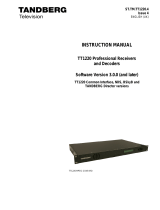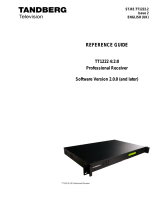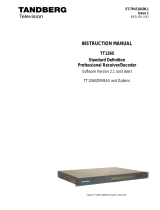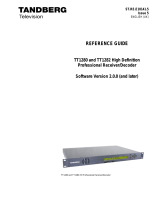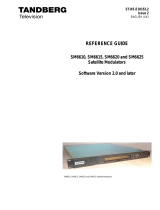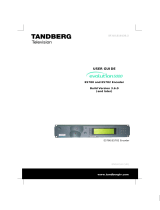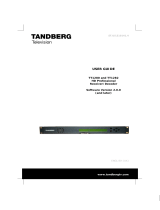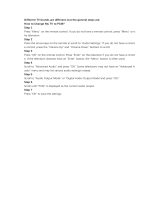Page is loading ...

ST.TM.TT1220.1
Issue 1
ENGLISH (UK)
INSTRUCTION MANUAL
TT1220 Professional Receivers
and Decoders
Software Version 2.2.0 (and later)
M2/TT1220CIF/S, M2/TT1220CIF/D
M2
/
TT122
0C
IF
/S
-EXT
,
M2
/
TT122
0
ND
S/S

Preliminary Pages
Page ii Instruction Manual: Professional Receivers and Decoders (IRD)
ST.TM.TT1220.1
Issue 1 first published in 2000 by:
T
ANDBERG TELEVISION LTD
REGISTERED ADDRESS:
35 B
ASINGHALL STREET
LONDON
EC2V 5DB
U
NITED KINGDOM
Registered Company Number 03695535
This document and the information contained in it is the property o
f
TANDBERG Television Ltd and may be the subject of patents
pending and granted. It must not be used for commercial purposes
nor copied, disclosed, reproduced, stored in a retrieval system or
transmitted in any form or by any means (electronic, mechanical,
photocopying, recording or otherwise), whether in whole or in part,
without TANDBERG Television’s prior written agreement.
2000 TANDBERG Television Ltd. All rights reserved.
SVENSKA
LÄS DETTA FÖRST!
Om Ni inte förstår informationen i denna handbok
ARBETA DÅ INTE MED DENNA UTRUSTNING.
En översättning till detta språk av denna handbok kan också anskaffas, på
Er bekostnad.
ENGLISH (UK)
READ THIS FIRST!
If you do not understand the contents of this manual
DO NOT OPERATE THIS EQUIPMENT.
Also, translation into any EC official language of this manual can be made
available, at your cost.
ΕΛΛΗΝΙΚΑ
ÄΙΑΒΑΣΤΕ ΠΡÙΤΑ ΑΥΤΟ!
Αν δεν καταλÜβετε το περιεχüìενο αυτοý του βοηθÞìατοò/εγχειριδßου
ΜΗΝ ΛΕΙΤΟΥΡΓΗΣΕΤΕ ΑΥΤΟΝ ΤΟΝ ΕΞΟΠΛΙΣΜΟ.
Επßσηò, αυτü το εγχειρßδιο εßναι διαθÝσιìο σε ìετÜφραση
σε αυτÞ τη γλþσσα και ìπορεßτε να το αγορÜσετε.
DEUTSCH
LESEN SIE ZUERST DIESEN HINWEIS!
Sollte Ihnen der Inhalf dieses Handbuches nicht klar verständlich sein,
dann
BEDIENEN SIE DIESE GERÄTE NICHT!
Eine Übersetzung des Handbuches in diese Sprache ist gegen
Berechnung lieferbar.
ESPAÑOL
LEA ESTE AVISO PRIMERO!
Si no entiende el contenido de este manual
NO OPERE ESTE EQUIPO.
Podemos asimismo suministrarle una traducción de este manual al
(idioma) previo pago de una cantidad adicional que deberá abonar usted
mismo.
FRANÇAIS
AVANT TOUT, LISEZ CE QUI SUIT!
Si vous ne comprenez pas les instructions contenues dans ce manuel
NE FAITES PAS FONCTIONNER CET APPAREIL.
En outre, nous pouvons vous proposer, à vos frais, une version française
de ce manuel.
ITALIANO
LEGGERE QUESTO AVVISO PER PRIMO!
Se non si capisce il contenuto del presente manuale
NON UTILIZZARE L’APPARECCHIATURA.
È anche disponibile la versione italiana di questo manuale, ma il costo è a
carico dell’utente.
PORTUGUÊS
LEIA O TEXTO ABAIXO ANTES DE MAIS NADA!
Se não compreende o texto deste manual
NÃO UTILIZE O EQUIPAMENTO.
O utilizador poderá também obter uma tradução do manual para o
português à própria custa.
NEDERLANDS
LEES DIT EERST!
Als u de inhoud van deze handleiding niet begrijpt
STEL DEZE APPARATUUR DAN NIET IN WERKING.
U kunt tevens, op eigen kosten, een vertaling van deze handleiding
krijgen.
DANSK
LÆS DETTE FØRST!
Udstyret må ikke betjenes
MEDMINDRE DE TIL FULDE FORSTÅR INDHOLDET AF DENNE
HÅNDBOG.
Vi kan også for Deres regning levere en dansk oversættelse af denne
håndbog.
SUOMI
LUE ENNEN KÄYTTÖÄ!
Jos et ymmärrä käsikirjan sisältöä
ÄLÄ KÄYTÄ LAITETTA.
Käsikirja voidaan myös suomentaa asiakkaan kustannuksella.

Preliminary Pages
Instruction Manual: Professional Receivers and Decoders (IRD) Page iii
ST.TM.TT1220.1
List of Contents
Chapter 1: Introduction
This chapter describes the purpose of the TT1220 in a typical system,
provides a summary of its main features and identifies the controls.
Chapter 2: Installing the Equipment
This chapter provides a guide to installing the equipment, including the
suitability of an installation, detailed procedures for the preparation,
installation and configuration. This chapter also includes important
safety information. It also lists the pin-outs for the various connectors,
and details the power cycle procedure.
Chapter 3: Operating the Equipment Locally
This chapter provides a guide to using the LCD interface and keypad. It
also details the setting up, configuration and operating procedures.
Chapter 4: Operating the Equipment Remotely
This chapter provides a guide to configuring the RS-232 remote control
port, and preparing the unit for remote operation. This chapter does not
detail the remote control procedure itself, as this is detailed in the
instructions for the individual control system.
Chapter 5: Alarms
This chapter provides a guide to configuring the alarm interface and
menus.
Chapter 6: Preventive Maintenance and Fault-Finding
This chapter details routine maintenance tasks to be performed, provides
general service advice, and information regarding warranty.
Annex A: Glossary
Annex B: Technical Specification
Annex C: Menus
Annex D: Alarm Categories and Conditions
Annex E: Using the TT1220 with the NDS Director System

Preliminary Pages
Page iv Instruction Manual: Professional Receivers and Decoders (IRD)
ST.TM.TT1220.1
About this Manual
This manual provides instructions and information for the installation and
operation of the TT1220 range of decoders.
This manual should be kept in a safe place for reference for the life of the
equipment. It is not intended that this manual will be amended by the
issue of individual pages. Any revision will be by a complete reissue.
Further copies of this manual can be ordered from the address shown on
page vi. If passing the equipment to a third party, also pass the relevant
documentation.
Issues of this manual are listed below:
Issue Date Software Version Comments
1 Dec 2000 1.0.0 Initial release.
2 Feb 2000 2.2.0 Phase 2 software updated release
Acknowledgements
General
All best endeavours have been made to acknowledge registered
trademarks and trademarks used throughout this manual. Any notified
omissions will be rectified in the next issue of this manual. Some
trademarks may be registered in some countries but not in others.
Registered trademarks and trademarks used are acknowledged below and
marked with their respective symbols. However, they are not marked
within the text of this manual.
Registered Trademarks
VideoGuard
®
is a registered trademark of NDS Limited.
Dolby Digital
®
and AC-3
®
are registered trademarks of Dolby Laboratories
Licensing Corporation.
Alteia plus
®
is a registered trademark of TANDBERG Television Limited.
Trademarks
Alteia
TM
is a trademark of TANDBERG Television Limited.
NDS Director
TM
is a trademark of NDS Limited.
Notice
This product incorporates copyright protection technology that is protected
by U.S. patents and other intellectual property rights. Use of this copyright
protection technology must be authorised by Macrovision, and is intended
limited by pay-per-view uses only unless otherwise authorised by
Macrovision. Reverse engineering or disassembly is prohibited.

Preliminary Pages
Instruction Manual: Professional Receivers and Decoders (IRD) Page v
ST.TM.TT1220.1
Warnings, Cautions and Notes
Heed Warnings
All warnings on the product and in the operating instructions should be
adhered to. The manufacturer can not be held responsible for injuries or
damage where warnings and cautions have been ignored or taken lightly.
Read Instructions
All the safety and operating instructions should be read before this product
is operated.
Follow Instructions
All operating and use instructions should be followed.
Retain Instructions
The safety and operating instructions should be retained for future
reference.
WARNINGS....
WARNINGS GIVE INFORMATION WHICH, IF STRICTLY OBSERVED, WILL PREVENT PERSONAL
INJURY OR DEATH, OR DAMAGE TO PERSONAL PROPERTY OR THE ENVIRONMENT. THEY
ARE BOXED AND SHADED FOR EMPHASIS, AS IN THIS EXAMPLE, AND ARE PLACED
IMMEDIATELY PRECEDING THE POINT AT WHICH THE READER REQUIRES THEM.
CAUTIONS...
Cautions give information which, if strictly followed, will prevent damage to equipment or other goods.
They are boxed for emphasis, as in this example, and are placed immediately preceding the point at
which the reader requires them.
NOTES...
Notes provide supplementary information. They are highlighted for emphasis, as in this example, and
are placed immediately after the relevant text.
EMC Compliance
This equipment is certified to the EMC requirements detailed in Annex B,
Technical Specification. To maintain this certification, only use the leads
supplied or if in doubt contact Customer Services.

Preliminary Pages
Page vi Instruction Manual: Professional Receivers and Decoders (IRD)
ST.TM.TT1220.1
Contact Information
TANDBERG Television Customer Services
Support Services
Our primary objective is to provide first class customer care that is tailored
to your specific business and operational requirements. All levels are
supported by one or more service performance reviews to ensure the
perfect partnership between TANDBERG Television and your business.
Levels of Support
We offer a number of support service levels so you can choose the one
most appropriate to your business requirements.
• For the initial 12 months, Bronze Level Support is provided free on this
product. An extended time period can be purchased for this level.
• Silver Level Support extends the coverage to include on-site support,
preventive maintenance and discount on predesigned training.
• The Gold Level Support gives an enhanced support package. It builds
on the Silver Level by including advanced repair exchange, an account
focused engineer, version migration support and further discount on
predesigned training.
Where to Find Us
Europe, Middle East +44 (0) 23 8048 4455
and Africa: Fax: +44 (0) 23 8048 4467
Americas Office: + 1 888 637 0023
fieldservice-ameri[email protected]
South Americas Office: + 1 949 725 2699
fieldservice-ameri[email protected]
Hong Kong Office: + 852 2899 7000
Australia/NZ Office: +61 2 9356 8599
Internet Address: http://www.tandbergtv.com

Preliminary Pages
Instruction Manual: Professional Receivers and Decoders (IRD) Page vii
ST.TM.TT1220.1
Technical Training
Training Courses
TANDBERG Television provides a wide range of training courses on the
operation and maintenance of our products and on their supporting
technologies. TANDBERG can provide both regularly scheduled courses and
training tailored to individual needs. Courses can be run either at your
premises or at one of our dedicated training facilities.
Where to Find Us
For further information on TANDBERG Television's training programme
please contact us:
International Telephone: +44 23 8048 4229
International Facsimile +44 23 8048 4467
E-mail Address: [email protected]
Internet Address http://www.tandbergtv.com
Customer Services and Technical Training Postal Address
Tandberg Television
Strategic Park
Comines Way
Hedge End
Southampton
Hampshire
SO30 4DA
United Kingdom
Technical Publications
If you need to contact TANDBERG Television Technical Publications
regarding this publication, e-mail: [email protected].

Preliminary Pages
Page viii Instruction Manual: Professional Receivers and Decoders (IRD)
ST.TM.TT1220.1
BLANK

Instruction Manual: Professional Receivers and Decoders (IRD) Page 1-1
ST.TM.TT1220.1
Chapter 1
1. Introduction
Contents
1.1 Scope of This Manual................................................1-3
1.1.1 Who Should Use This Manual.......................1-3
1.1.2 What This Manual Describes........................1-3
Identifying The Equipment............................1-3
1.2 Summary of Features................................................1-3
1.2.1 Main Features...............................................1-3
All Models......................................................1-3
Options..........................................................1-4
Unique Features, NDS VideoGuard
Director Version............................................1-5
Unique Features, DVB Common Interface
Version..........................................................1-5
1.2.2 Inputs............................................................1-5
Transport Stream Input.................................1-5
1.2.3 Outputs..........................................................1-6
Transport Stream Output..............................1-6
Video Outputs...............................................1-6
Audio Outputs...............................................1-6
Data Output...................................................1-6
Alarm Output.................................................1-6
1.2.4 Conditional Access........................................1-6
1.3 TT1220 Control Modes.............................................1-7
1.3.1 Introduction...................................................1-7
1.3.2 Remote Control.............................................1-7
1.3.3 Over the Air Control......................................1-7
1.3.4 Local Control.................................................1-7
1.4 Guided Tour..............................................................1-8
1.4.1 Construction..................................................1-8
1.4.2 Front Panel Controls.....................................1-8
Overview.......................................................1-8
Edit and Save...............................................1-8
Cancel an Edit..............................................1-9
1.4.3 Front Panel LED...........................................1-9
1.4.4 Conditional Access.......................................1-9
1.4.5 Rear Panel....................................................1-9
List of Figures
Figure 1.1: TT1220.........................................................................1-3
Figure 1.2: Navigating the Menus..................................................1-8
Figure 1.3: Editing Values in a Menu.............................................1-8

Introduction
Page 1-2 Instruction Manual: Professional Receivers and Decoders (IRD)
ST.TM.TT1220.1
BLANK

Introduction
Instruction Manual: Professional Receivers and Decoders (IRD) Page 1-3
ST.TM.TT1220.1
1.1 Scope of This Manual
1.1.1 Who Should Use This Manual
This manual is written for operators / users of the TANDBERG TT1220
range of professional receivers and decoders. It describes the unit’s
functions and operation. The manual is written to assist in the installation
and day-to-day care and operation of the unit. Maintenance information
requiring the covers to be removed is not included.
CAUTION…
Removing the covers of this equipment may invalidate the warranty.
1.1.2 What This Manual Describes
Identifying The Equipment
The receivers and decoders described in this manual are the base models.
These are designated by the marketing numbers:
M2/TT1220CIF/xxx for the common interface version
M2/TT1220NDS/xxx for the NDS VideoGuard version
TT12 20 IRD
Digital Video
Broadcasting
TA ND BERG
R
MPEG-2
Figure 1.1: TT1220
The type of unit can be identified as follows:
• The TT1220 common interface version has a common interface slot at
the rear, below and right of the QPSK or ASI input. The common
interface module has to be inserted first, before a smart card may be
inserted.
• The TT1220 NDS VideoGuard version has a smart card reader slot at
the rear, below and right of the QPSK or ASI input. A NDS VideoGuard
smart card may be inserted directly into the unit.
1.2 Summary of Features
1.2.1 Main Features
All Models
The receivers and decoders are fully compliant with the appropriate
sections of the MPEG-2
1
and DVB-S
2
specifications.
1
Moving Pictures Expert Group: MPEG-2 specification ISO 13818.
2
European Digital Video Broadcasting (DVB) Project. EN 300 421 Digital broadcasting systems for television, sound
and data services: Framing structure, channel coding, and modulation for the 11/12 GHz satellite service.

Introduction
Page 1-4 Instruction Manual: Professional Receivers and Decoders (IRD)
ST.TM.TT1220.1
The TT1220 range offers the following features:
• Single QPSK RF input:
L-Band input
• Or ASI input:
Factory selectable mounting of a DVB-ASI BNC input
• Front panel controls and indications:
A 2 row by 20 character back lit LCD display provides information
and allows operator choice entry
Four pushbuttons provide the control interface in conjunction with
the LCD display
Single LED provides status information
• Service selection:
Chosen from a menu list of available services carried in the
currently received transport stream in PSI/SI enabled mode.
• Video decoding:
4:2:0 MP@ML mode support video resolutions up to 720 pixels x
576 active lines (25 frame/s) or 720 pixels x 480 active lines (30
frame/s)
No 4:2:2 support
Support for PAL- (B, D, G, H, I, M and Combination N)
Support for SECAM- (B, G, H, D, K, K1, L) Line ID
Support for NTSC (M)
2 x composite video outputs
• Audio decoding:
According to MPEG-1 Layer I and II (Musicam)
Sampling rates 32, 44.1 and 48 kHz
All MPEG-1 Layer I and II bit-rates
1 x 9-pin D-sub output
• Data:
Low speed data: RS-232 asynchronous (up to 115.2 kbit/s)
• Conditional access:
In addition to product specific CA, all units offer BISS (mode 0
and 1) support
• Vertical blanking interval (VBI) signalling support:
In 625 lines: VITS test lines, WST (EBU) Teletext insertion, VPS
and WSS is supported
In 525 lines: Closed captioning and V.Chip signalling are supported
• Remote control:
RS-232, TANDBERG proprietary control solution
Options
3
• Transport stream output:
3
Not all options available on all models. Some options only available when ordering as part of a new product. For
information about the different options and their availability, please contact your TANDBERG Television representative.
Software upgradeable options may incur a nominal fee.

Introduction
Instruction Manual: Professional Receivers and Decoders (IRD) Page 1-5
ST.TM.TT1220.1
One DVB-ASI BNC output, user configured to provide a semi-
descrambled output stream (selected service descrambled)
• SDI video output:
Replaces one of the composite video outputs
• Audio output:
Two stereo pairs, that replace the single one in the base model.
Both stereo connectors provide MPEG-1 layer I and II (Musicam)
analogue decoded streams
S/PDIF output option – SW upgradeable (only on 2 channel
version)
AC-3 passthrough option – SW upgradeable (only on 2 channel
version)
AC-3 downmix option (only on 2 channel version)
2 x 9-pin D-sub output
• Signal protection:
TANDBERG Television proprietary CA system
Unique Features, NDS VideoGuard Director Version
• Conditional access:
NDS Director CA support or
BSkyB CA support
• Over the air control:
NDS Director over the air control (only on NDS Director version)
• Control relays:
Four relays available
Unique Features, DVB Common Interface Version
• Conditional access:
DVB Common Interface CA support
• Control relays:
One relay is available
1.2.2 Inputs
Transport Stream Input
The main input of the TT1220 is the QPSK f-connector, located on the rear
of the unit. This input interfaces directly to Low-Noise Block (LNB) and
accepts an intermediate frequency (IF) input in the 950 – 2150 MHz
(L-band) range. The unit can provide DC power, that may be used for
polarisation switching on the LNB, as well as a 22 kHz control signal. The
maximum input symbol rate is 44,5 Msym/s, while the maximum total
bit-rate is 60 Mbit/s.
An optional (factory fitted) DVB-ASI BNC connector may be present,
replacing the QPSK f-connector. This input accepts a DVB-ASI compliant
signal (188 or 204 byte), at a maximum of 60 Mbit/s.

Introduction
Page 1-6 Instruction Manual: Professional Receivers and Decoders (IRD)
ST.TM.TT1220.1
1.2.3 Outputs
Transport Stream Output
One DVB-ASI BNC connector may be available. This provides the current
incoming transport stream, including the current descrambled service, to
be output at a maximum of 60 Mbit/s.
Video Outputs
Two BNC composite analogue video outputs are present on the rear of the
unit. If the factory fitted option of a SDI video output is present, it
replaces one of the composite outputs.
Audio Outputs
One analogue stereo audio pair carried on a 9-pin D-SUB connector, is
available. Depending on the input, it is menu configurable to allow one
stereo, a dual-mono or two independent mono channels. The channels can
carry different languages.
The primary audio output might be replaced by the extended audio output
option, which allows for two stereo audio pairs carried on two 9-pin D-SUB
connectors.
Depending on the configured options, the extended audio output may be
able to either provide analogue balanced audio, AES/EBU digital audio,
AC-3 digital passthrough, or AC-3 to analogue Dolby Pro-Logic downmix.
Data Output
RS-232 asynchronous low speed data output carried on a 9-way D-sub
connector, available on all models. The data output rate is configurable
from 1200 bit/s to 115200 bit/s.
Alarm Output
Failure, alarm and warning monitoring is user configurable from the menu
system, and performed within the equipment. When the equipment is in
an erred state, the alarm is signalled both via the front panel alarm LED,
and via the 9-way D-sub alarm relay connector, located on the rear of the
unit. For instructions on configuring the alarms, see Chapter 5, Alarms. For
a description of the alarm relay, see Chapter 2, Installing the Equipment.
1.2.4 Conditional Access
The following conditional access systems are standard on the TT1220
range of decoders.
• No conditional access
• Signal protection (if fitted)
• EBU BISS (mode 0 and mode 1)

Introduction
Instruction Manual: Professional Receivers and Decoders (IRD) Page 1-7
ST.TM.TT1220.1
Further CA systems are available on the specific models:
NDS Videoguard Director Version
• NDS Director CA
NDS Videoguard BSkyB Version
• NDS Videoguard BSkyB CA
DVB CI Version
• Any DVB compliant CA system, utilising a DVB compliant common
interface CA module
1.3 TT1220 Control Modes
1.3.1 Introduction
The TT1220 is designed for unattended operation. Once set up, it requires
no further attention except to ensure that the fan is working. There are
three control modes associated with the receiver, local (keypad), remote
(RS-232), and over the air control (OAC)
4
.
1.3.2 Remote Control
This state is entered when the Ctrl. Mode setting in the Adv:System
Options menu is set to remote. When the decoder is remotely controlled,
local control is disabled until the decoder is configured for the local mode.
1.3.3 Over the Air Control
This state is entered when the Ctrl. Mode setting in the Adv:System
Options menu is set to OAC. When the decoder is remotely controlled,
local control is disabled until the decoder is configured for the local mode.
1.3.4 Local Control
Local control allows parameters to be entered and chosen using the four
keypad buttons.
The buttons roles and functions change, depending on what kind of menu
or screen is available at the moment.
The up / down buttons are used for previous / next item in a menu,
previous / next option in an option select menu (for instance, on or off) or
the higher / lower digit in a numerical entry menu.
The right / left buttons are used to enter / leave a menu or submenu, and
to select the next or previous digit in a numerical entry menu.
4
OAC is a feature for NDS Videoguard Director only

Introduction
Page 1-8 Instruction Manual: Professional Receivers and Decoders (IRD)
ST.TM.TT1220.1
1.4 Guided Tour
1.4.1 Construction
The receiver is constructed using a screened fan-ventilated chassis. All
operational inputs and outputs are via the rear panel connectors. The unit
may be operated free-standing on a horizontal flat surface, or mounted in
a 19” rack. 1RU rack height is required. It is important that horizontal
airflow is not obstructed, to maintain the airflow required to cool the unit.
1.4.2 Front Panel Controls
Overview
The front panel is fitted with a keypad that is used to set up and monitor
the unit. Information on the use of these controls is given in Chapter 3,
Operating the Equipment Locally. Figure 1.2 gives an overview on how to
navigate the menus. Figure 1.3 explains how to edit these values once a
menu item is selected.
Figure 1.2: Navigating the Menus.
Figure 1.3: Editing Values in a Menu.
Edit and Save
In the edit mode, when the correct value is in place, exit and save by
pressing multiple times to the right, to move the cursor outside the edit
area. When the cursor leaves the edit area, the new setting will be saved,
and the keypad will revert to the navigation mode.
Increment
value
Position Cursor
Decrement
value
Position Cursor
Move cursor up /
scroll up
Return to
previous menu
Select item
at cursor
Move cursor down /
scroll down

Introduction
Instruction Manual: Professional Receivers and Decoders (IRD) Page 1-9
ST.TM.TT1220.1
Cancel an Edit
In the edit mode, if you have incorrectly entered a value, cancel and exit
by pressing multiple times to the left, to move the cursor outside the edit
area. When the cursor leaves the edit area, the previous setting will
reappear, and the keypad will revert to the navigation mode.
NOTE…
Keypad access may be locked, easily recognised by the small lock in the top left corner of the display.
To navigate the menus, escape the locked mode by pressing left, right, 3 x left and then 3 x right in
sequence. This will take you from the default status screen, to the main menu.
1.4.3 Front Panel LED
The unit is fitted with one LED, showing the status of the unit. When the
LED lights up red, an alarm condition has been met, according to the
alarm set-up described in Annex D, Alarm Categories and Conditions.
1.4.4 Conditional Access
5
NDS Videoguard Director Version
There is one slot on the rear of the unit, to allow the insertion of a
Conditional Access (CA) card for the NDS Director VideoGuard system.
NDS Videoguard BSkyB Version
There is one slot on the rear of the unit, to allow the insertion of a
Conditional Access (CA) card for the NDS VideoGuard BSkyB system.
DVB CI Version
There is one slot on the rear of the unit, to allow the insertion of a DVB
common interface (CI) conditional access module. The DVB CI unit will
host the Conditional Access (CA) card for the CA system that matches the
DVB CI module.
1.4.5 Rear Panel
All input and output connectors are located on the rear panel. Connector
descriptions are given in Chapter 2, Installing the Equipment.
5
Note: All CA systems are mutually exclusive.

Introduction
Page 1-10 Instruction Manual: Professional Receivers and Decoders (IRD)
ST.TM.TT1220.1
BLANK

Instruction Manual: Professional Receivers and Decoders (IRD) Page 2-1
ST.TM.TT1220.1
Chapter 2
2. Installing the Equipment
Contents
2.1 Read this First!..........................................................2-3
2.1.1 Handling........................................................2-3
2.1.2 Installing the Equipment................................2-3
2.1.3 Lifting.............................................................2-3
2.2 Preliminary Checks....................................................2-3
2.2.1 Mechanical Inspection...................................2-3
2.2.2 Moving the Equipment Safely.......................2-3
2.3 Installing the Equipment............................................2-4
2.3.1 Fixing.............................................................2-4
2.3.2 Ventilation .....................................................2-4
Openings in the Covers.................................2-4
Care in Positioning........................................2-4
Protection From Moisture..............................2-4
2.3.3 Installing Cables – Safety..............................2-5
2.3.4 Outdoor Antenna...........................................2-5
Lightning Protection......................................2-5
Power Lines..................................................2-5
2.4 EMC Compliance Statements...................................2-6
2.4.1 EMC Compliance Approval...........................2-6
2.4.2 EN 55022, EN 55024, EN 61000-3-2, EN
61000-3-3 FCC part 15B class A, ICES-
003 and AS/NZS 3548..................................2-6
2.4.3 FCC...............................................................2-6
2.4.4 Connecting to a Public
Telecommunication System..........................2-6
2.5 AC Supply Voltage and Fusing – Safety
Information.................................................................2-7
2.5.1 AC Power Supply..........................................2-7
2.5.2 Technical Earth.............................................2-7
2.5.3 AC Power Supply Cord.................................2-8
General.........................................................2-8
Disposal of Moulded Plugs...........................2-8
Wire Colours.................................................2-8
2.5.4 Connecting the Equipment to the AC
Power Supply................................................2-8
2.6 Signal Connections...................................................2-9
2.6.1 General.........................................................2-9
2.6.2 Input Connectors..........................................2-9
Overview.......................................................2-9
Technical Earth.............................................2-9
Remote Connector......................................2-10
L-band Input (on QPSK Input Models)........2-10
ASI Input (on ASI Input Models).................2-11
2.6.3 Output Connectors......................................2-11
Analogue Composite Video Output............2-11
Digital Video Output (SDI, Option)..............2-12
Audio Output...............................................2-12
RS-232 Low-speed Asynchronous Data
Output.........................................................2-14
Alarm Relay................................................2-14
List of Figures
Figure 2.1: Openings in the Cabinet ..............................................2-4
Figure 2.2: EMC Compliance Label...............................................2-6
Figure 2.3: Common Interface Version..........................................2-9
Figure 2.4: NDS VideoGuard Version............................................2-9
Figure 2.5: Technical Earth Connector..........................................2-9

Installing the Equipment
Page 2-2 Instruction Manual: Professional Receivers and Decoders (IRD)
ST.TM.TT1220.1
List of Tables
Table 2.1: Fuse information...........................................................2-7
Table 2.2: Supply Cord Wiring Colours .........................................2-8
Table 2.3: RS-232 Connector......................................................2-10
Table 2.4: QPSK Satellite Receiver (L-band) Connector ............2-10
Table 2.5: DVB-ASI Connector....................................................2-11
Table 2.6: Analogue Video Connector.........................................2-11
Table 2.7: Digital Video Connector..............................................2-12
Table 2.8: Analogue Audio Connectors.......................................2-12
Table 2.9: AC-3 Downmix / Passthrough Connector...................2-13
Table 2.10: Serial Digital Audio (S/PDIF) Connectors.................2-13
Table 2.11: RS-232 Low-speed Data Connector.........................2-14
Table 2.12: Alarm Connector.......................................................2-14
/
